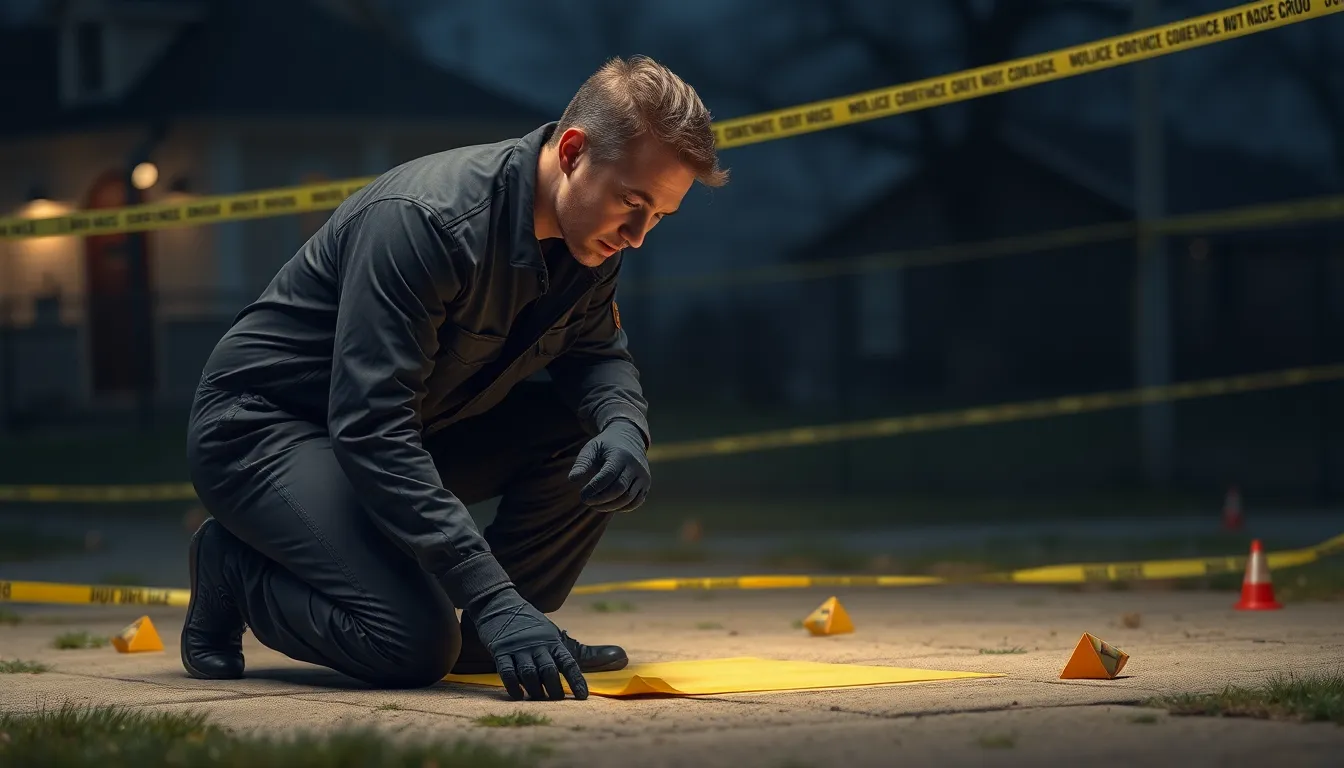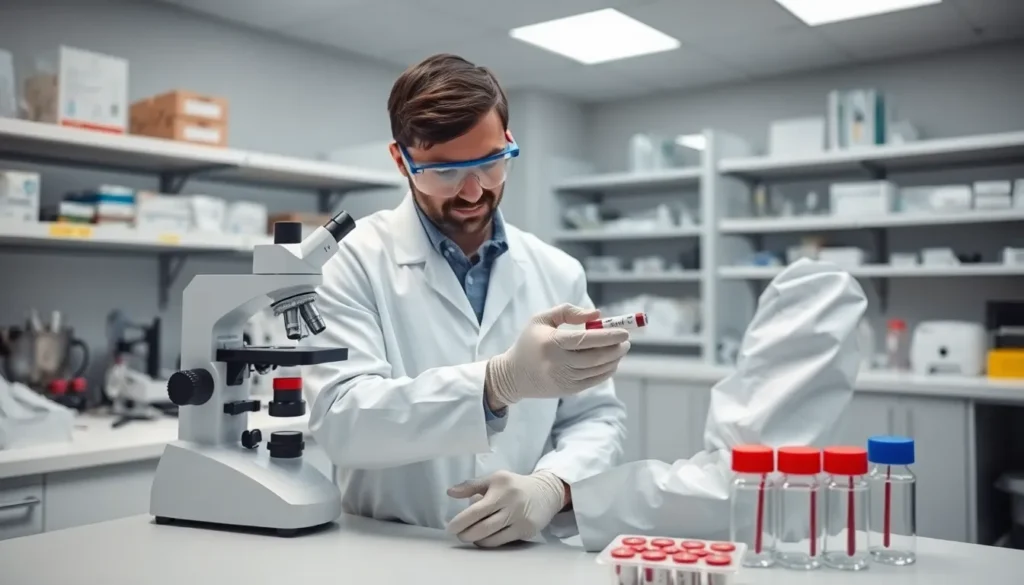Table of Contents
ToggleForensic investigations are like the ultimate detective story, but with a lot more science and a lot less dramatic music. When a crime occurs, it’s not just about who done it; it’s about how they did it and what clues they left behind. From analyzing fingerprints to examining trace evidence, forensic experts piece together the puzzle, turning chaos into clarity.
Overview of Forensic Investigations
Forensic investigations encompass various scientific methods used to solve crimes. These investigations require meticulous attention to detail, ensuring that every piece of evidence is examined thoroughly. Experts analyze various forms of evidence, including fingerprints, blood samples, and trace materials. Each piece of evidence contributes to reconstructing the events surrounding a crime.
The role of forensic scientists is crucial for establishing facts about how a crime occurred. They apply principles from chemistry, biology, and physics to interpret the evidence. Their findings can provide insights about suspect behavior and the sequence of events. For example, DNA analysis often reveals critical links between suspects and victims.
Tools and techniques in forensic science continue to advance, enhancing the accuracy of analyses. Emerging technologies, such as digital forensics, analyze electronic data from devices. These findings can uncover vital information about communication and actions leading up to a crime.
Collaboration among various forensic specialists is essential. Criminalists, forensic pathologists, and toxicologists often work together to piece together information. Their interdisciplinary approach strengthens the reliability of evidence and conclusions.
Understanding the process of forensic investigations allows people to appreciate the complexity of solving crimes. Evidence serves not only to identify perpetrators but also to provide closure to victims and the community. Each investigation contributes to the broader goals of justice and public safety, demonstrating the significant impact of forensic science in the criminal justice system.
Key Components of Forensic Investigations

Forensic investigations rely on several critical components that ensure comprehensive analysis and accurate conclusions. Each aspect plays a vital role in solving crimes and delivering justice.
Crime Scene Analysis
Crime scene analysis involves meticulously examining the location where an offense occurred. Investigators document the scene through photography and sketches while noting the positioning of evidence. Each detail matters, as it helps reconstruct the sequence of events. Witness statements provide additional context, aiding in understanding the dynamics of the situation. Specialists determine the best method to preserve the integrity of the scene, ensuring that no evidence is contaminated or lost. Accurate crime scene analysis lays the groundwork for successful investigations.
Evidence Collection
Evidence collection is crucial for obtaining reliable information. Technicians follow strict protocols to gather various types of evidence, which may include physical items, biological samples, and trace materials. Each sample undergoes careful labeling and handling to maintain its chain of custody. Investigators prioritize non-invasive collection methods to preserve evidence’s integrity. The quality of collected evidence significantly influences the investigation’s outcome, making this step fundamental in linking suspects to crimes. A thorough collection process ensures a robust foundation for subsequent analysis.
Forensic Lab Techniques
Forensic lab techniques encompass a variety of scientific methods used to analyze collected evidence. Techniques such as DNA analysis, toxicology testing, and fingerprint matching are standard practices in forensic labs. Each method generates critical data that supports investigative efforts. Labs utilize advanced technology, including mass spectrometry and gas chromatography, to enhance accuracy. Skilled forensic scientists interpret results, offering insights into potential suspects or events. Through the integration of these techniques, investigators establish connections between the evidence and the case, building a stronger case for prosecution.
Major Types of Forensic Investigations
Forensic investigations encompass various specialized fields, each designed to address specific types of evidence and inquiries. Understanding these categories aids in navigating the complexities of forensic science.
Criminal Forensics
Criminal forensics focuses on crimes against individuals or society. This field includes analyzing physical evidence like fingerprints, blood, or firearms. Forensic scientists employ techniques such as DNA profiling to link suspects to crime scenes. Ballistics experts examine bullets and firearms to reconstruct events. Analysis of drugs and toxic substances provides insights into motives or causes of death. The results from criminal forensics assist law enforcement and legal teams in building strong cases for prosecution.
Civil Forensics
Civil forensics addresses legal disputes unrelated to criminal wrongdoing. This includes issues like personal injury claims, property disputes, and contract violations. Forensic experts evaluate evidence, providing opinions based on factual findings. Examination of accident scenes or product failures often helps determine liability. Document analysis can uncover forgery or misrepresentation. In civil cases, findings contribute to settlements or court verdicts, ensuring just outcomes.
Digital Forensics
Digital forensics investigates electronic devices and data. This field examines computers, smartphones, and networks to recover hidden or deleted information. Specialists utilize software tools to conduct thorough data analyses, tracking activities or communications during criminal investigations. Preserving data integrity is crucial for presenting evidence in court. Cybersecurity incidents also fall under this domain, allowing experts to trace unauthorized access or data breaches. Ultimately, digital forensics supports both criminal and civil cases, revealing critical facts concealed within technology.
Challenges in Forensic Investigations
Forensic investigations face multiple challenges that can impede justice. These challenges include legal and ethical issues, as well as technological limitations.
Legal and Ethical Considerations
Legal frameworks surrounding forensic evidence can complicate investigations. Admissibility often depends on strict guidelines, which require forensic evidence to be collected and analyzed according to established standards. Violations can lead to the exclusion of vital evidence in court. Ethical dilemmas also arise, especially regarding the handling of sensitive information. Respecting victims and their families while maintaining transparency is crucial. Balancing the rights of suspects with the need for public safety presents an ongoing challenge in forensic investigations.
Technological Limitations
Technological advancements enhance forensic capabilities but come with limitations. Processing large data sets from digital forensics requires significant time and resources. Additionally, equipment malfunctions or outdated technology can hinder accurate analyses. The complexity of interpreting forensic data often increases as new techniques emerge. Some forensic tools lack standardization, creating variability in results. Reliance on technology becomes problematic when systems fail, affecting the overall integrity of investigations.
Future Trends in Forensic Investigations
New technologies are revolutionizing forensic investigations. Artificial intelligence simplifies data analysis, speeding up the processing of large cases. Machine learning algorithms improve pattern recognition, enhancing the identification of suspects through vast data sets. Automated systems can now sift through thousands of digital records to uncover vital evidence that might otherwise go unnoticed.
Advancements in DNA analysis continue to push the boundaries of forensic science. Rapid DNA testing allows for on-site analysis at crime scenes, increasing the chances of immediate identification of suspects. This capability drastically reduces the time from evidence collection to actionable information. Non-invasive techniques, such as low-copy number DNA analysis, enable forensic scientists to use extremely small samples effectively.
Collaboration among various disciplines is vital. Integrating forensic psychology into criminal investigations strengthens the understanding of suspect behavior. Cross-functional teams, composed of forensic experts, digital specialists, and legal advisors, create a holistic approach to solving crimes. This teamwork enhances the quality of investigations, ensuring that all evidence is thoroughly examined from multiple perspectives.
Emerging trends in 3D crime scene reconstruction are reshaping how crime scenes are visualized. These detailed representations allow juries and investigators to navigate scenes interactively, providing clearer insights into the events surrounding a crime. Virtual reality tools are beginning to be utilized for training purposes, preparing forensic professionals for real-life scenarios.
Regulatory changes also play a role in shaping the future. New standards are continually developed to ensure forensic evidence remains reliable and admissible in court. Maintaining consistency across laboratories and practices enhances the credibility of forensic findings, ultimately affecting justice outcomes. Adapting to these changes is essential for staying relevant in an evolving field.
Cyber forensics continues to gain importance. Investigators are increasingly focused on securing digital evidence as cybercrime rates rise. Legal frameworks surrounding data privacy and cybersecurity challenges require constant updates to forensic practices. Addressing these complexities strengthens both criminal and civil investigations in the digital age.
Forensic investigations are vital in the pursuit of justice. They combine scientific rigor with investigative techniques to uncover the truth behind crimes. The collaboration among various specialists enhances the reliability of evidence and strengthens cases in court.
As technology continues to evolve, so do the methods used in forensic science. Innovations like artificial intelligence and advanced DNA analysis are transforming the field, making it more efficient and effective. Understanding these advancements is essential for anyone interested in the complexities of crime-solving.
Ultimately, forensic investigations not only identify perpetrators but also provide closure to victims and their families. The ongoing development in this field ensures that justice remains a priority in society.


